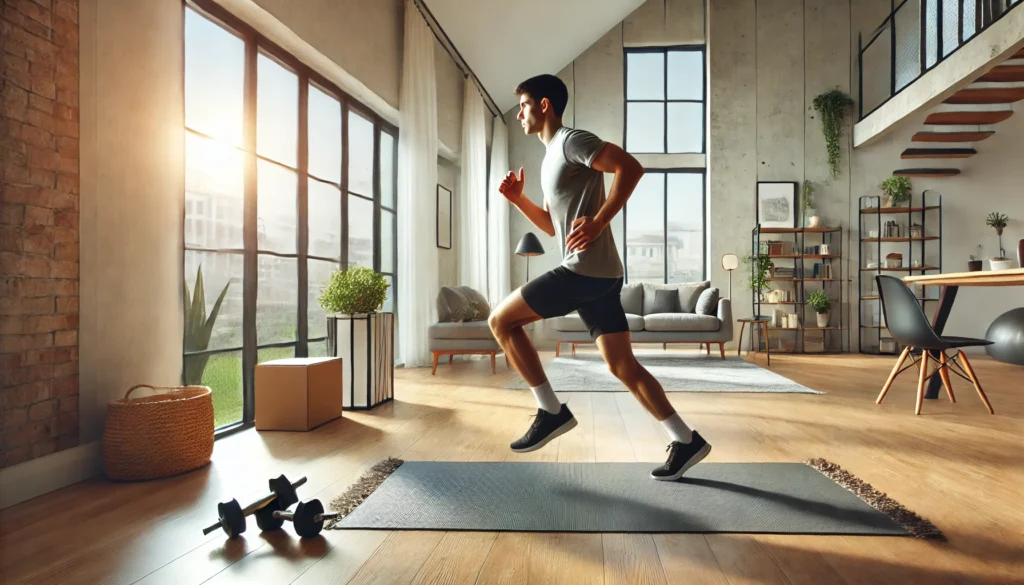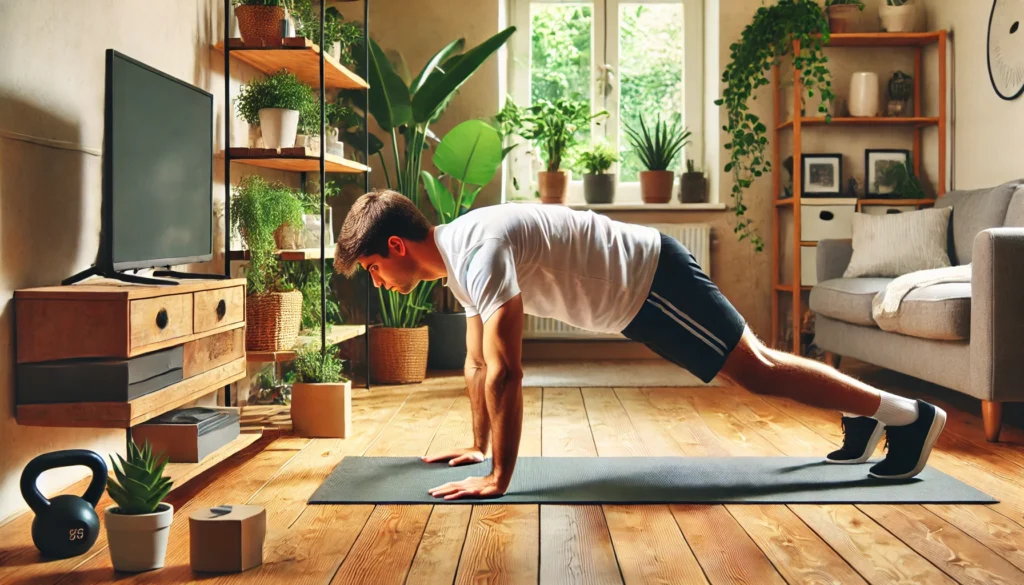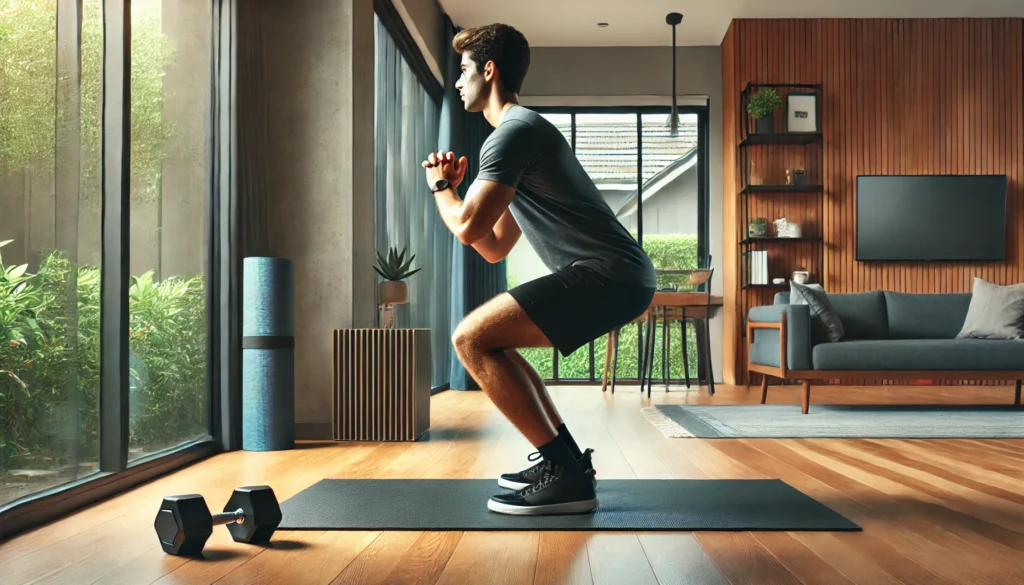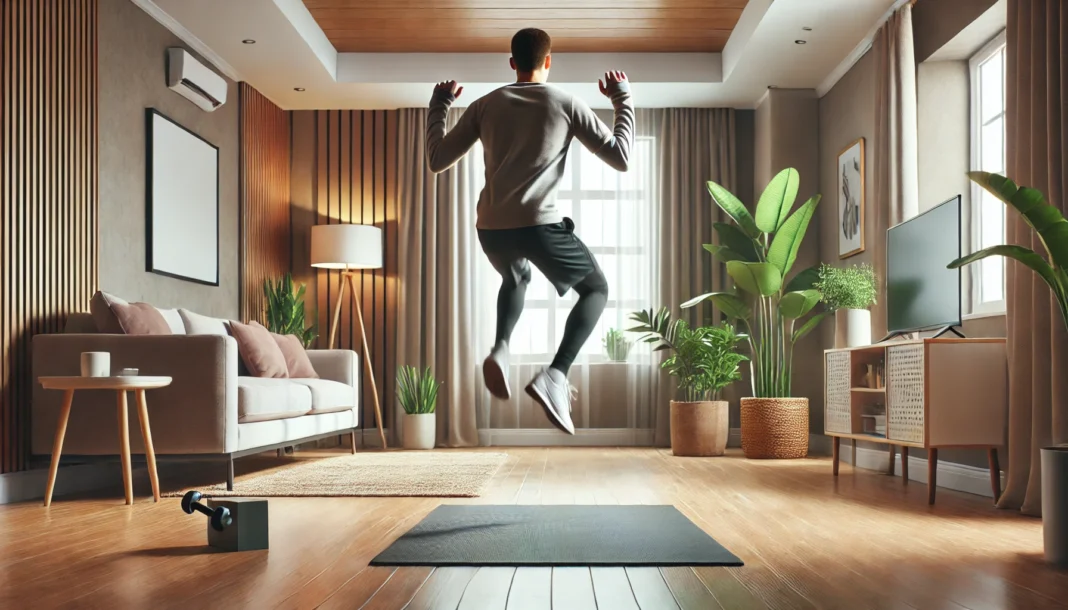Introduction: The Benefits of Low Impact Cardio Exercises at Home
Engaging in low impact cardio exercises at home is an excellent way to enhance cardiovascular health, build endurance, and improve overall fitness without putting excessive strain on the joints. Unlike high-intensity workouts that can be taxing on the body, these routines prioritize fluid movement and controlled exertion, making them ideal for individuals of all fitness levels. Low impact cardiovascular exercises are particularly beneficial for beginners, older adults, and those recovering from injuries, as they allow for sustainable movement patterns that support long-term fitness goals. In addition, these workouts provide an effective way to burn calories, boost heart health, and elevate mood while minimizing the risk of injury. Incorporating low impact cardio training into a weekly fitness regimen ensures that individuals achieve their fitness objectives in a sustainable and injury-free manner.
You may also like: The Ultimate Bodyweight Workout Routine for Full-Body Strength and Performance
The Science Behind Low Impact Cardiovascular Exercises
Understanding the mechanics of low impact cardiovascular exercises helps in maximizing their effectiveness. Unlike high-impact activities such as running or jumping, low impact cardio training focuses on continuous movement without excessive force on the knees, hips, and ankles. This distinction is particularly crucial for individuals with joint issues, as it allows them to engage in cardiovascular workouts without discomfort. Scientific studies have shown that engaging in a light cardio workout consistently improves heart rate variability, a key indicator of cardiovascular fitness. Additionally, these exercises increase oxygen circulation, enhance lung capacity, and promote metabolic efficiency, ensuring that the body operates optimally. The strategic incorporation of good low impact cardio exercises into daily routines fosters endurance, strength, and overall well-being.
The Best Low Impact Cardio Exercises at Home for All Fitness Levels
One of the most appealing aspects of low impact cardio at home is its adaptability to different fitness levels. For beginners, light aerobic workouts such as marching in place, step touches, and arm swings offer an accessible entry point into cardiovascular training. Intermediate exercisers can incorporate brisk walking, seated leg lifts, and bodyweight movements to increase intensity while maintaining joint safety. Advanced participants can integrate resistance-based movements, such as controlled squats and modified burpees, to further enhance cardiovascular endurance without excessive impact. Each of these options allows individuals to engage in low impact cardio exercises at home in a way that aligns with their personal fitness capabilities and goals. By selecting exercises that match their current conditioning, individuals can gradually build endurance without overwhelming their bodies.
Incorporating Light Cardio Workouts for Weight Management and Fat Loss
Many people turn to low impact cardio training as a method for effective weight management. While high-intensity workouts are often associated with calorie burning, a well-structured light cardio workout can be just as effective for fat loss when performed consistently. The key lies in maintaining an elevated heart rate over an extended duration, allowing the body to efficiently utilize stored fat as an energy source. Exercises such as low impact jumping jacks, side steps, and slow jogging in place serve as effective tools for sustaining fat-burning intensity without causing excessive strain. Additionally, pairing these exercises with a balanced diet and strength training can enhance metabolism and promote long-term weight control. Those seeking an easy-to-follow fat loss routine can benefit from the easiest cardio movements while ensuring sustainability and adherence.

The Role of Low Impact Cardio Training in Rehabilitation and Injury Prevention
One of the most compelling reasons to adopt low impact cardio training is its role in injury rehabilitation and prevention. Many physical therapists and fitness experts recommend light exercise at home for individuals recovering from injuries or managing chronic conditions. Movements such as slow cycling, swimming, and elliptical training provide an effective cardiovascular stimulus without aggravating pre-existing injuries. Additionally, these exercises strengthen stabilizing muscles and improve joint mobility, reducing the likelihood of future injuries. By engaging in a structured low impact cardio workout at home, individuals recovering from injuries can maintain their fitness levels while ensuring proper recovery and rehabilitation.
Enhancing Endurance and Stamina Through Light Aerobic Workouts
While low impact exercises at home may appear to be less intense than high-impact workouts, they still significantly contribute to endurance and stamina. Engaging in prolonged sessions of light cardio exercises gradually conditions the heart and lungs to sustain higher levels of activity. Over time, individuals experience improved energy levels, reduced fatigue, and greater overall physical resilience. Incorporating progressive training principles, such as increasing duration and varying intensity, ensures continuous cardiovascular improvement. The benefits extend beyond fitness, as enhanced endurance contributes to increased productivity and improved daily functionality.
The Psychological and Mental Health Benefits of Low Impact Cardio
Beyond its physical advantages, low impact cardio training has a profound impact on mental well-being. Scientific research has demonstrated that engaging in consistent physical activity, including light cardio workouts, leads to reduced stress levels and improved mood. Endorphin release during exercise contributes to a sense of relaxation, helping individuals combat anxiety and depression. Additionally, structured workouts promote discipline, routine, and self-efficacy, reinforcing positive behavioral patterns. Regular participation in light exercise at home fosters mental clarity, enhances cognitive function, and cultivates an overall sense of well-being.
The Best Equipment for Enhancing Low Impact Cardio at Home
While many low impact cardio exercises require no equipment, incorporating simple tools can add variety and effectiveness to a workout. Resistance bands, small hand weights, and stability balls help introduce light resistance, enhancing muscle engagement without excessive strain. Treadmills and stationary bikes provide controlled environments for sustained cardio sessions, allowing individuals to maintain a steady pace and monitor progress. Jump ropes with weighted handles offer a lower-impact alternative to traditional jump rope workouts, making them suitable for those with joint concerns. By integrating these tools, individuals can elevate their home workouts and ensure continued progress toward their fitness goals.
How to Structure a Low Impact Cardio Workout at Home for Maximum Results
To maximize the benefits of a low impact cardio workout at home, structuring the session effectively is essential. A well-rounded workout includes a five-minute warm-up to prepare the muscles, followed by 20-40 minutes of continuous movement. Alternating between different movements, such as step-ups, lateral lunges, and slow kickboxing combinations, keeps the heart rate elevated while minimizing boredom. The session should conclude with a cooldown phase, incorporating stretching to promote muscle recovery and flexibility. By maintaining a structured approach, individuals can ensure that their workouts remain effective and sustainable in the long term.

Frequently Asked Questions (FAQ) on Low Impact Cardio Exercises at Home
1. How effective are low impact cardio exercises at home compared to high-impact workouts?
Low impact cardio exercises at home can be just as effective as high-impact workouts when structured correctly. The key is to maintain consistent movement, elevate the heart rate, and engage multiple muscle groups to achieve cardiovascular benefits. Unlike high-impact activities such as running or jumping, low impact cardiovascular exercises reduce stress on the joints, making them ideal for long-term sustainability. Additionally, they provide excellent endurance training and can be incorporated into interval-style workouts for added intensity. Many individuals find that alternating between light cardio exercises and strength training enhances overall fitness while minimizing the risk of injury.
2. Can low impact cardio training help with weight loss?
Absolutely. Engaging in the best low impact cardio routines consistently promotes calorie burn and fat loss. The key to weight loss is maintaining a caloric deficit, and a well-designed low impact cardio workout at home can contribute significantly to this goal. Activities such as brisk walking, dancing, and light aerobic workouts keep the metabolism active without excessive strain on the body. Pairing these exercises with strength training and a balanced diet further enhances fat-burning potential while maintaining muscle mass.
3. What are some good low impact cardio exercises for beginners?
Beginners should start with exercises that promote movement without overwhelming the body. Some good low impact cardio exercises include step touches, side-to-side lunges, seated marches, and slow-paced squats. These movements engage major muscle groups while keeping the intensity manageable. Gradually increasing duration and intensity ensures steady progress without excessive fatigue. Over time, individuals can transition to more dynamic low impact cardio workouts at home, such as modified burpees and resistance-based movements.
4. How can light cardio workouts benefit individuals with joint pain or injuries?
Low impact cardio exercises are ideal for individuals with joint pain or injuries because they reduce stress on the knees, hips, and ankles while still promoting movement. Activities like swimming, cycling, and controlled step movements help maintain cardiovascular health without exacerbating pain. Light exercise at home, such as yoga-based flows and seated aerobics, can improve mobility and circulation. Strengthening surrounding muscles through light workouts at home further supports joint stability. Over time, these exercises enhance flexibility and reduce discomfort, making daily activities easier.
5. Can low impact cardio at home improve endurance and stamina?
Yes, low impact cardio training can significantly enhance endurance and stamina when performed consistently. Training the cardiovascular system through sustained, moderate-intensity movement increases the body’s ability to use oxygen efficiently. Engaging in activities like marching in place, light aerobic workouts, and controlled bodyweight movements builds endurance without excessive fatigue. Over time, increasing duration and incorporating resistance-based exercises enhances overall stamina. This makes it easier to transition into more advanced fitness routines while maintaining joint safety.
6. Are there specific techniques to make the easiest cardio workouts more effective?
To maximize the benefits of even the easiest cardio routines, focus on intensity, duration, and consistency. Increasing arm movement, engaging the core, and incorporating slight resistance enhances calorie burn. Performing exercises in intervals—such as alternating between 30 seconds of movement and 15 seconds of rest—adds an element of challenge without increasing impact. Incorporating good low impact cardio exercises like controlled step-ups or arm circles ensures sustained cardiovascular engagement. Additionally, maintaining proper posture and controlled breathing optimizes energy expenditure and efficiency.
7. How does a light cardio workout contribute to heart health?
A light cardio workout plays a crucial role in maintaining heart health by improving circulation and enhancing oxygen uptake. Engaging in consistent low impact cardio exercises strengthens the heart muscle, making it more efficient at pumping blood throughout the body. Activities such as rhythmic step exercises and slow-paced dance movements elevate the heart rate safely. This reduces the risk of heart disease, lowers blood pressure, and enhances overall cardiovascular endurance. Regular participation in low impact cardio training fosters long-term cardiovascular wellness.
8. Can low impact exercises at home be incorporated into a strength training program?
Absolutely. Combining low impact cardio exercises with strength training provides a well-rounded fitness approach. For example, alternating between bodyweight squats and marching in place keeps the heart rate elevated while building muscle. Resistance bands and light weights can be integrated into light cardio exercises to enhance muscular endurance. This combination not only improves cardiovascular fitness but also supports metabolism and overall functional movement. Structuring workouts to include both elements ensures a balanced and effective routine.
9. What are some effective ways to stay motivated when doing light workouts at home?
Maintaining motivation for home workouts can be challenging, but setting clear goals, tracking progress, and varying routines help sustain interest. Creating a designated workout space enhances focus and consistency. Incorporating music, following online workout programs, or engaging in virtual challenges keeps routines engaging. Additionally, setting small milestones, such as increasing workout duration or mastering a new movement, provides a sense of accomplishment. Finding a workout partner or joining an online fitness community can also offer accountability and support.
10. How can someone progress from a beginner’s light exercise at home routine to more advanced training?
Progressing from beginner-friendly routines to more advanced low impact cardio workouts requires gradual adjustments in intensity and complexity. Increasing workout duration, incorporating light resistance, and modifying movements for greater engagement enhance overall fitness. For example, adding controlled plyometric elements, such as slow jump squats with soft landings, builds strength while maintaining joint safety. Gradually transitioning to full-body circuits and incorporating interval training further increases endurance. Listening to the body and making adjustments based on personal fitness levels ensures steady and sustainable improvement.

Conclusion: Elevating Fitness with Safe and Effective Low Impact Cardio
Engaging in the best low impact cardio exercises at home offers a safe and effective means of improving cardiovascular health, boosting endurance, and managing weight. By selecting exercises that align with individual fitness levels and goals, anyone can create a sustainable routine that supports long-term well-being. Whether used for rehabilitation, fat loss, or overall health improvement, low impact cardiovascular exercises provide a holistic approach to fitness. Through consistency, progressive adaptation, and mindful movement, individuals can enjoy the numerous benefits of low impact cardio training without unnecessary strain on their bodies. As fitness continues to evolve, the accessibility and effectiveness of these exercises remain a valuable asset for individuals seeking a balanced and sustainable approach to health.
heart health, endurance training, joint-friendly workouts, home fitness routines, non-impact cardio, safe cardiovascular workouts, sustainable fitness, aerobic endurance, metabolic conditioning, low-stress workouts, exercise recovery, gentle cardio, rehabilitation exercises, holistic fitness, long-term health, cardiovascular conditioning, movement therapy, fitness adaptation, wellness training, active lifestyle.
Further Reading:
Try This: 6 Low-Impact Cardio Exercises in 20 Minutes or Less
19 Cardio Exercises for a Gym-Free Workout
21 Low Impact Cardio Exercises To Protect Your Joints
Important Note: The content provided by HealthXWire is for informational purposes only and should not be construed as medical advice, diagnosis, or treatment. While we strive for accuracy, the information presented on this site may not reflect the most current research or medical guidelines. Always seek the advice of your physician or other qualified health provider with any questions you may have regarding a medical condition. HealthXWire does not endorse, recommend, or guarantee the efficacy of any products, services, or treatments mentioned on this site. Users should not disregard professional medical advice or delay seeking it because of something they have read on HealthXWire. HealthXWire is not liable for any damages, loss, or injury arising from reliance on the information provided herein.



